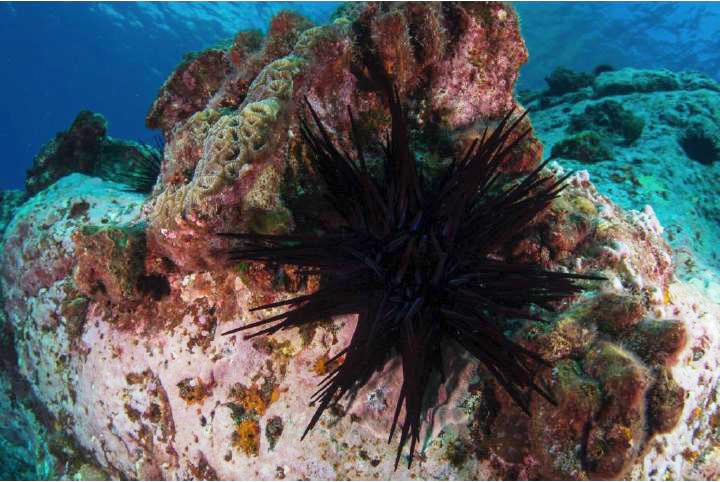Marine travellers best able to adapt to warming waters

The urchin, Centrostephanus rodgersii, has moved into the waters of Tasmania, forming extensive rock barrens, leading to large-scale community change. Credit Rick Stuart-Smith
Marine species that already roam far and wide throughout our oceans are extending their territories further and faster in response to climate change, according to new research involving the University of Southampton and an international team of biodiversity experts.
The study found that while species that have large ranges are able to make their way to cooler waters, small-ranging species are in increased jeopardy as our planet's oceans continue to warm.
“Our findings indicate that animals which already have wide-latitudinal ranges, habitat generalists, and species with high adult mobility displayed the quickest and greatest range shifts,” says University of British Columbia biodiversity researcher Dr Jennifer Sunday, lead author of the study.
As expected, swimming ability is important. Fish are stretching their ranges south faster than other organisms such as starfish and crustaceans. Researchers also found that animals that have large range sizes are also at equilibrium with their environment, and are therefore the most responsive to change and shift the fastest.
“The study is among the first to comprehensively look at how a marine animal's traits impact their ability to respond to climate change and highlights the importance of biology as a predictive tool,” says Dr Amanda Bates from the University of Southampton, who co-led the workshop that developed the idea for the study.
The findings, which have been published in Ecology Letters, may be useful for improving global predictions of how different species will respond to climate change and for identifying those in greatest jeopardy due to their limited ability to escape warming.
The researchers used a global marine hotspot, the fast-warming waters off Australia's east coast, as their lab. In Eastern Australia, the ocean has been warming four times faster than the global average–and many marine species have been appearing further south than ever before.
The tiger shark, short-tail stingray and barren-forming urchin were some of the fish species with the largest range shifts in the region. Filter-feeding barnacles–omnivores that are notoriously invasive–also displayed some of the largest expansions of territory.
Meanwhile the spotted handfish, a coastal species in the same region, hasn't extended its distributional range into cooler waters despite shifting temperatures.
###
Notes for editors
1. Picture: The urchin, Centrostephanus rodgersii, has moved into the waters of Tasmania, forming extensive rock barrens, leading to large-scale community change. Credit Rick Stuart-Smith
2. For a copy of the paper: Species traits and climate velocity explain geographic range shifts in an ocean-warming hotspot DOI: 10.1111/ele.12474 please contact media relations.
3. For interview opportunities with Dr Amanda Bates please call media relations.
4. Through world-leading research and enterprise activities, the University of Southampton connects with businesses to create real-world solutions to global issues. Through its educational offering, it works with partners around the world to offer relevant, flexible education, which trains students for jobs not even thought of. This connectivity is what sets Southampton apart from the rest; we make connections and change the world. http://www.
http://www.
#weareconnected
For further information contact:
Steven Williams, Media Relations, University of Southampton, Tel: 023 8059 2128, email: S.Williams@soton.ac.uk
http://www.
Follow us on twitter: http://twitter.
Like us on Facebook: http://www.
Media Contact
All latest news from the category: Earth Sciences
Earth Sciences (also referred to as Geosciences), which deals with basic issues surrounding our planet, plays a vital role in the area of energy and raw materials supply.
Earth Sciences comprises subjects such as geology, geography, geological informatics, paleontology, mineralogy, petrography, crystallography, geophysics, geodesy, glaciology, cartography, photogrammetry, meteorology and seismology, early-warning systems, earthquake research and polar research.
Newest articles

Recovering phosphorus from sewage sludge ash
Chemical and heat treatment of sewage sludge can recover phosphorus in a process that could help address the problem of diminishing supplies of phosphorus ores. Valuable supplies of phosphorus could…

Efficient, sustainable and cost-effective hybrid energy storage system for modern power grids
EU project HyFlow: Over three years of research, the consortium of the EU project HyFlow has successfully developed a highly efficient, sustainable, and cost-effective hybrid energy storage system (HESS) that…

After 25 years, researchers uncover genetic cause of rare neurological disease
Some families call it a trial of faith. Others just call it a curse. The progressive neurological disease known as spinocerebellar ataxia 4 (SCA4) is a rare condition, but its…





















